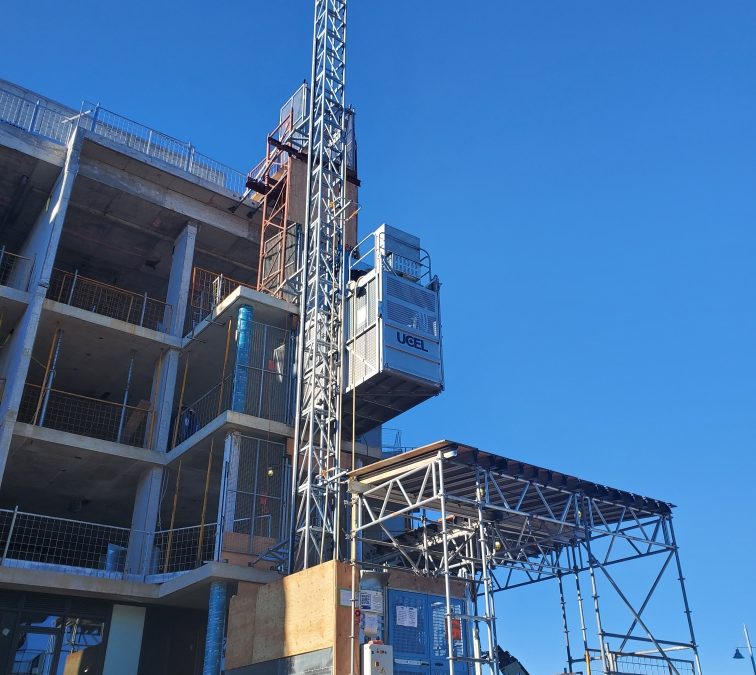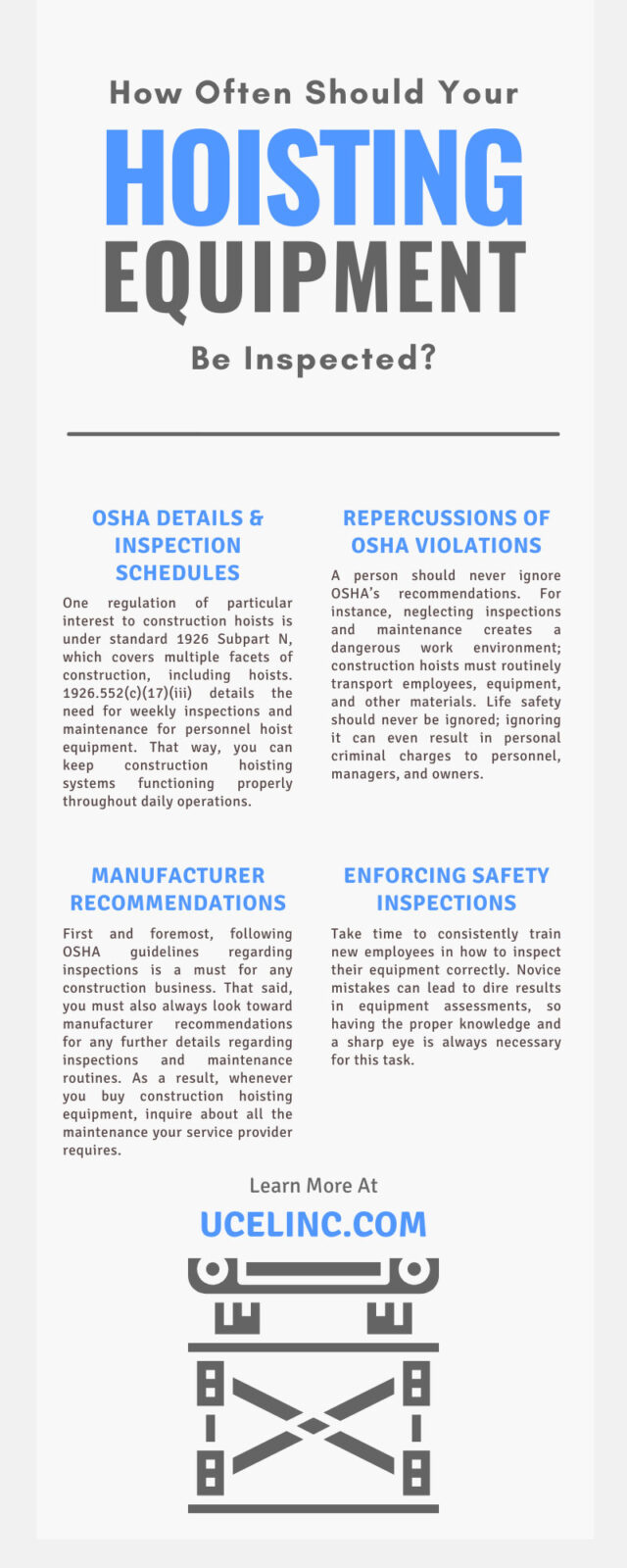Construction hoists are elevator-like systems that allow construction workers to transport personnel and workplace materials to significant heights. Most commonly, you’ll find construction hoists functioning on high-rises. Whether you’re building the high-rise or updating an existing building, a suitable construction hoist will help you do it responsibly.
That said, given the substantial heights at which personnel work with these hoists, taking the proper safety measures is vital. Therefore, one of the most basic but essential rules is to conduct routine inspections with hoisting gear.
Understandably, this begs the question: How often should your hoisting equipment be inspected? Read our comprehensive guide below to learn how often you must examine your gear and why it’s such a crucial part of day-to-day operations.
OSHA Regulations
The Occupational Health and Safety Administration (OSHA) proposes many different guidelines and regulations for workplaces to follow regularly. Of course, the construction industry is no exception to OSHA’s rules because heavy machinery is prevalent on job sites.
For example, inspecting construction hoists is an integral part of working with such equipment. Luckily, OSHA features its regulations prominently on its website, ensuring you can conveniently track down all the applicable rules.
OSHA Details & Inspection Schedules
One regulation of particular interest to construction hoists is under standard 1926 Subpart N, which covers multiple facets of construction, including hoists. In addition, standard 1926.552 specifically covers personnel hoists, elevators, and other equipment in the field.
This regulation is full of rich, vital information for keeping workplaces safe and responsible, including section 1926.552(c), which delves into personnel lifts exclusively. For instance, 1926.552(c)(17)(iii) details the need for weekly inspections and maintenance for personnel hoist equipment. That way, you can keep construction hoisting systems functioning properly throughout daily operations.
Furthermore, 1926.552(c)(17)(iii) clarifies that inspections are always in order after your hoisting gear interacts with winds surpassing speeds of 35 mph. Although that might sound surprising to newcomers to the subject, it’s vital to understand that seemingly minor details can make or break a hoist’s success. Now, let’s delve into what happens when workplaces violate these OSHA guidelines.
Repercussions of OSHA Violations
Violating OSHA rules for hoisting equipment inspections isn’t a good move for safety and financial reasons. OSHA puts rules and regulations for workplace practices into effect for critical reasons; these rules keep companies functioning efficiently and safely, protecting workers and the public
A person should never ignore OSHA’s recommendations. For instance, neglecting inspections and maintenance creates a dangerous work environment; construction hoists must routinely transport employees, equipment, and other materials. Life safety should never be ignored; ignoring it can even result in personal criminal charges to personnel, managers, and owners.
So if equipment components are insufficient for completing such transportation needs, you should not use them until they are in a functional state. At the end of the day, under the watch of responsible workplace professionals, objects and humans should never fall. Unfortunately, construction accidents can happen for many reasons. Not only should business owners understand OSHA safety guidelines, but employees should, too, because they’re the ones working with the equipment daily, and this is the law.
As you’ll learn below, creating a safe work environment has surprising effects.
Deeper Repercussions of Unsafe Environments
Personnel on construction sites shouldn’t feel trepidatious every time they step into a hoist or elevator. Of course, situational awareness is always vital, but employees should feel like they’re in good hands regarding equipment quality.
In other words, the safety of your operation significantly impacts the workplace atmosphere. To some, the atmosphere might seem like a small part of the overall operation. However, peace of mind will help employees focus on their specific roles instead of worrying about equipment reliability constantly. Good equipment quality and reliability will increase jobsite productivity. Furthermore, buying equipment from reliable sources will help you achieve that peace of mind successfully.
Manufacturer Recommendations
First and foremost, following OSHA guidelines regarding inspections is a must for any construction business. That said, you must also always look toward manufacturer recommendations for any further details regarding inspections and maintenance routines. As a result, whenever you buy construction hoisting equipment, inquire about all the maintenance your service provider requires. In doing so, you can create a suitable, safe inspection routine for every job site that uses hoisting systems. By law, this information should be located in an instruction manual, which is provided with every construction hoist or industrial elevator. The typical cycles of inspection are daily, weekly, monthly, annually, and every three years; each cycle carries its’ own requirements.
Finding Reliable Partners
Experience with construction hoists will vary between vendors and manufacturers, so be sure you’re partnering with reputable professionals. After all, equipment manufacturers and vendors must follow their own safety protocols regularly. Otherwise, they’re setting up construction companies to fail from the start.
For instance, at UCEL, we’re very careful with the equipment manufacturers we partner with for buck hoists and other vertical transportation equipment. That way, we can provide you with equipment that functions safely and reliably on day one. We often partner with ISO9001 facilities, in addition to normally requiring that all equipment meet or exceed local codes without any client modification.
The need for finding reliable partners adds even more responsibility to equipment inspections. If you buy faulty equipment, you can spot the issue quickly by conducting an initial visual assessment and follow-ups every week, preventing potential accidents in the process.
Enforcing Safety Inspections
In many states, the government takes on a large portion of responsibility for inspecting equipment—including overseeing drop testing and being present for initial installation. However, this does not diminish an owner or workers’ legal and contracted obligations.
As you can see, the topic of construction hoist inspections is far-reaching. It’s only one of the many safety rules you must follow on sites, but conducting regular inspections is essential for efficiency, safety, and professionalism in the field. All these factors will help you create a thriving construction force, no matter what project you’re working on next.
For this reason, take time to consistently train new employees in how to inspect their equipment correctly. Novice mistakes can lead to dire results in equipment assessments, so having the proper knowledge and a sharp eye is always necessary for this task. In addition, consistent monitoring of personnel is necessary to help workers avoid deviating from reasonable hoist practices.
Getting Too Comfortable
Unfortunately, when employees work a specific job for enough time, they can get too comfortable, putting safety guidelines to the side due to over-confidence, which can lead to safety risks. Thankfully, educating your team and enforcing the proper rules will help you prevent safety risks from becoming commonplace on every job site.
Suffice it to say, anyone operating the titular equipment should be able to answer the question: How often should your hoisting equipment be inspected? Although they might not know the answer at first, all members of your team can learn the ropes successfully with the proper training and guidance.

